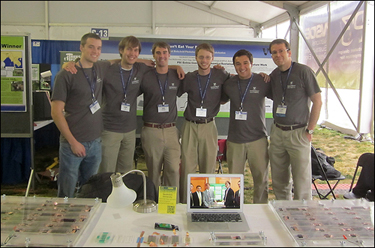EPA awards $90,000 to VU seniors to develop a spinach-powered solar cell
by Vanderbilt School of Engineering | April 24, 2012
Earth Day 2012 proved exceptionally green for a Vanderbilt University team of five engineering seniors who designed a biohybrid solar panel that substitutes a protein from spinach for expensive silicon wafers that are energy intensive to produce, and is capable of producing electricity.
The team won a Phase II $90,000 grant at the 8th Annual National Sustainable Design Expo held at the National Mall in Washington, D.C., over Earth Day weekend.
The Expo – co-sponsored by the U.S. Environmental Protection Agency – featured 44 university and college teams competing for Phase II funding under the EPA’s People, Prosperity and the Planet (P3) student design competition. More than 30 exhibitors from nonprofits and government agencies also showcased innovative environmental solutions.

Not only did the Vanderbilt senior design team earn advanced funding intended to further develop the design, implement it in the field, or move it to the marketplace, they also won the Marketplace Innovation Award from Paladin Capital, a private equity firm, and the Student Choice Award, a special nod from their peers in competition.
“The team absolutely excelled in clearly presenting their engineering innovations to the public. From the first minutes of the competition, they generated a buzz that rapidly spread across vast P3 exhibition space. We were one of only two teams (out of 44) to win three awards,” said Kane Jennings, professor of chemical engineering and one of the team’s two mentors.
The students – Eric Dilbone, Phil Ingram, Trevan Locke, Paul McDonald and Jason Ogg – had won a Phase I $15,000 grant in November from the EPA for their bio-inspired solar panel. Dilbone and Ingram are senior mechanical engineering majors; Locke, McDonald and Ogg are senior chemical engineering majors.
“After seeing the level of competition this weekend, we were thrilled with our results and we were proud to represent Vanderbilt on a national level,” said Dilbone. “The crowd was overwhelmingly fascinated by what we have done with spinach. There were a great number of people who wanted us to email them updates and provide them with a website where we can continue to showcase our progress.”
A last-minute strategy session before traveling to D.C. produced some clear tactics.
“There was no doubt that the scaled-up panel would be a star attraction, but there were nagging doubts about how the slight power from the panel would convince the judges,” said Amrutur Anilkumar, professor of the practice of mechanical engineering and a mentor.
At the strategy session, the team established some taglines:
- “The project has the power to inspire.”
- “We’ve taken the first steps to scale a laboratory-proven science.”
- “We’ve shown that the quantum efficiency of the cells can be improved.”
- And, “It would be possible to expand the power by a few orders of magnitude with Phase II funding.”
Armed with this game plan they set out to win over the judges.
The Vanderbilt team had designed a novel, large-scale biohybrid solar panel for power production from many individual photoelectrochemical cells that employ photosynthetic proteins as the active elements for light-harvesting and energy conversion.
A miniature bio-cell can produce minute electricity from Photosystem I (PSI), the protein in plant chloroplasts that converts light to electrochemical energy. The team extracted PSI from spinach and used it as the working medium in the bio-photovoltaic cells. The two scaled-up panels consist of 24 cells connected in series with each cell measuring 75 x 38 mm.
Production of such a scaled-up device has never been attempted before. “They have standardized a production and assembly scheme that can serve as a footprint for future scale up of next generation cells,” said Anilkumar.
“We built on the foundation laid by last year’s seniors, who worked on the initial EPA proposal. Now it’s our turn to contribute something and move on,” said Philip Ingram.
“We worked hard and our efforts are clearly visible in the professional design of our final project. The future for this project is bright – few orders of magnitude greater power output just utilizing current research alone,” Ingram said. “It makes me happy to know that just as this project was handed down to our team by graduates last year, we hand down the project to other undergraduates in the coming two years.”
“With the funding we will right away work on the research aspects of achieving the higher energy conversion goals for the individual cells,” said Jennings.
“Then, a new senior design team will be selected to establish standard protocols for quality control, testing and analysis, so that assembly would be a breeze and the end product would be as desired,” said Anilkumar.

Leave a Response